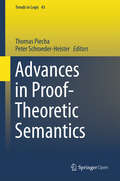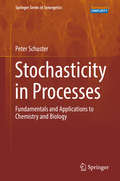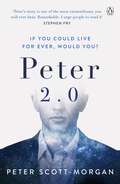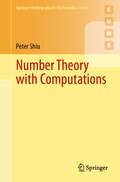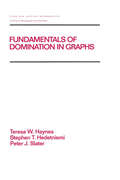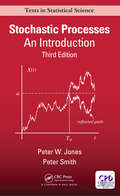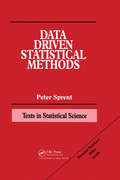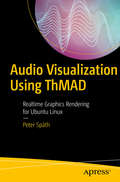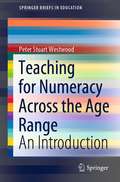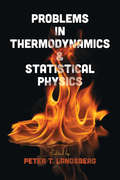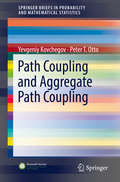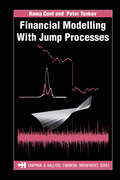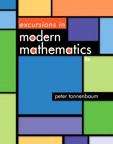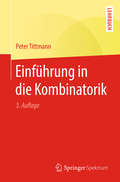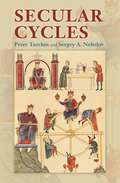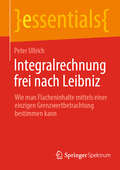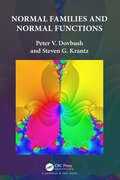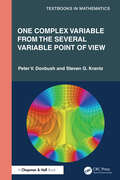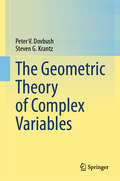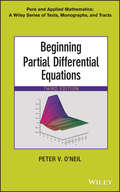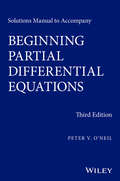- Table View
- List View
Galois Representations and (φ, Γ)-Modules
by Peter SchneiderUnderstanding Galois representations is one of the central goals of number theory. Around 1990, Fontaine devised a strategy to compare such p-adic Galois representations to seemingly much simpler objects of (semi)linear algebra, the so-called etale (phi, gamma)-modules. This book is the first to provide a detailed and self-contained introduction to this theory. The close connection between the absolute Galois groups of local number fields and local function fields in positive characteristic is established using the recent theory of perfectoid fields and the tilting correspondence. The author works in the general framework of Lubin–Tate extensions of local number fields, and provides an introduction to Lubin–Tate formal groups and to the formalism of ramified Witt vectors. This book will allow graduate students to acquire the necessary basis for solving a research problem in this area, while also offering researchers many of the basic results in one convenient location.
Advances in Proof-Theoretic Semantics (Trends in Logic #43)
by Thomas Piecha Peter Schroeder-HeisterThis volume is the first ever collection devoted to the field of proof-theoretic semantics. Contributions address topics including the systematics of introduction and elimination rules and proofs of normalization, the categorial characterization of deductions, the relation between Heyting's and Gentzen's approaches to meaning, knowability paradoxes, proof-theoretic foundations of set theory, Dummett's justification of logical laws, Kreisel's theory of constructions, paradoxical reasoning, and the defence of model theory. The field of proof-theoretic semantics has existed for almost 50 years, but the term itself was proposed by Schroeder-Heister in the 1980s. Proof-theoretic semantics explains the meaning of linguistic expressions in general and of logical constants in particular in terms of the notion of proof. This volume emerges from presentations at the Second International Conference on Proof-Theoretic Semantics in Tübingen in 2013, where contributing authors were asked to provide a self-contained description and analysis of a significant research question in this area. The contributions are representative of the field and should be of interest to logicians, philosophers, and mathematicians alike.
Stochasticity in Processes
by Peter SchusterThis book has developed over the past fifteen years from a modern course on stochastic chemical kinetics for graduate students in physics, chemistry and biology. The first part presents a systematic collection of the mathematical background material needed to understand probability, statistics, and stochastic processes as a prerequisite for the increasingly challenging practical applications in chemistry and the life sciences examined in the second part. Recent advances in the development of new techniques and in the resolution of conventional experiments at nano-scales have been tremendous: today molecular spectroscopy can provide insights into processes down to scales at which current theories at the interface of physics, chemistry and the life sciences cannot be successful without a firm grasp of randomness and its sources. Routinely measured data is now sufficiently accurate to allow the direct recording of fluctuations. As a result, the sampling of data and the modeling of relevant processes are doomed to produce artifacts in interpretation unless the observer has a solid background in the mathematics of limited reproducibility. The material covered is presented in a modular approach, allowing more advanced sections to be skipped if the reader is primarily interested in applications. At the same time, most derivations of analytical solutions for the selected examples are provided in full length to guide more advanced readers in their attempts to derive solutions on their own. The book employs uniform notation throughout, and a glossary has been added to define the most important notions discussed.
Peter 2.0: The Human Cyborg
by Peter Scott-MorganThe incredible book behind the primetime Channel 4 documentary, Peter: The Human Cyborg'A remarkable account of what it means to be human and what technology can really achieve' Sunday Telegraph'Peter's story is one of the most extraordinary you will ever hear. I urge people to read it' Stephen Fry'A remarkable story . . . you're left desperate to take nothing for granted' Radio Times __________ Peter, a brilliant scientist, is told that he will lose everything he loves. His husband. His family. His friends. His ability to travel the world. All will be gone. But Peter will not give up. He vows that this will not be the end and instead seeks a completely new beginning . . . Peter has Motor Neurone Disease, a condition universally considered by doctors to be terminal. He is told it will destroy his nerve cells and that within about two years, it will take his life too. But, face-to-face with death, he decides there is another way. Using his background in science and technology, he navigates a new path, one that will enable him not just to survive, but to thrive. This is the astonishing true story about Peter Scott-Morgan: the first person to combine his very humanity with artificial intelligence and robotics to become a full Cyborg. His discovery means that his terminal diagnosis is negotiable, something that will rewrite the future.And change the world. By embracing love, life and hope rather than fear, tragedy and despair, he will become Peter 2.0. __________'Compelling . . . Scott-Morgan is a true one-off. It is in the telling of the love story, rather than the technical details of becoming a cyborg, that this book succeeds' The Times 'What's striking is Peter's constant optimism, bravery and his ability to find radical answers to problems that have confounded Britain's brightest minds' Daily Telegraph 'A soaring love story' Financial Times 'Fascinating and extremely moving' Sun
Number Theory with Computations (Springer Undergraduate Mathematics Series)
by Peter ShiuThis introductory text is designed for undergraduate courses in number theory, covering both elementary number theory and analytic number theory. The book emphasises computational aspects, including algorithms and their implementation in Python. The book is divided into two parts. The first part, on elementary number theory, deals with concepts such as induction, divisibility, congruences, primitive roots, cryptography, and continued fractions. The second part is devoted to analytic number theory and includes chapters on Dirichlet’s theorem on primes in arithmetic progressions, the prime number theorem, smooth numbers, and the famous circle method of Hardy and Littlewood. The book contains many topics not often found in introductory textbooks, such as Aubry’s theorem, the Tonelli–Shanks algorithm, factorisation methods, continued fraction representations of e, and the irrationality of 𝜁(3). Each chapter concludes with a summary and notes, as well as numerous exercises. Assuming only basic calculus for the first part of the book, the second part assumes some knowledge of complex analysis. Familiarity with basic coding syntax will be helpful for the computational exercises.
Fundamentals of Domination in Graphs (Chapman & Hall/CRC Pure and Applied Mathematics)
by Teresa W. Haynes Stephen Hedetniemi Peter Slater"Provides the first comprehensive treatment of theoretical, algorithmic, and application aspects of domination in graphs-discussing fundamental results and major research accomplishments in an easy-to-understand style. Includes chapters on domination algorithms and NP-completeness as well as frameworks for domination."
Stochastic Processes: An Introduction, Third Edition
by Peter Smith Peter Watts JonesBased on a well-established and popular course taught by the authors over many years, Stochastic Processes: An Introduction, Third Edition, discusses the modelling and analysis of random experiments, where processes evolve over time. The text begins with a review of relevant fundamental probability. It then covers gambling problems, random walks, and Markov chains. The authors go on to discuss random processes continuous in time, including Poisson, birth and death processes, and general population models, and present an extended discussion on the analysis of associated stationary processes in queues. The book also explores reliability and other random processes, such as branching, martingales, and simple epidemics. A new chapter describing Brownian motion, where the outcomes are continuously observed over continuous time, is included. Further applications, worked examples and problems, and biographical details have been added to this edition. Much of the text has been reworked. The appendix contains key results in probability for reference. This concise, updated book makes the material accessible, highlighting simple applications and examples. A solutions manual with fully worked answers of all end-of-chapter problems, and Mathematica® and R programs illustrating many processes discussed in the book, can be downloaded from crcpress.com.
Strategies for Social Inquiry: Behind the Model
by Peter SpieglerThis ambitious book looks 'behind the model' to reveal how economists use formal models to generate insights into the economy. Drawing on recent work in the philosophy of science and economic methodology, the book presents a novel framework for understanding the logic of economic modeling. It also reveals the ways in which economic models can mislead rather than illuminate. Importantly, the book goes beyond purely negative critique, proposing a concrete program of methodological reform to better equip economists to detect potential mismatches between their models and the targets of their inquiry. Ranging across economics, philosophy, and social science methods, and drawing on a variety of examples, including the recent financial crisis, Behind the Model will be of interest to anyone who has wondered how economics works - and why it sometimes fails so spectacularly.
Data Driven Statistical Methods
by Peter SprentCalculations once prohibitively time-consuming can be completed in microseconds by modern computers. This has resulted in dramatic shifts in emphasis in applied statistics. Not only has it freed us from an obsession with the 5% and 1% significance levels imposed by conventional tables but many exact estimation procedures based on randomization tests are now as easy to carry out as approximations based on normal distribution theory. In a wider context it has facilitated the everyday use of tools such as the bootstrap and robust estimation methods as well as diagnostic tests for pinpointing or for adjusting possible aberrations or contamination that may otherwise be virtually undetectable in complex data sets. Data Driven Statistical Methods provides an insight into modern developments in statistical methodology using examples that highlight connections between these techniques as well as their relationship to other established approaches. Illustration by simple numerical examples takes priority over abstract theory. Examples and exercises are selected from many fields ranging from studies of literary style to analysis of survival data from clinical files, from psychological tests to interpretation of evidence in legal cases. Users are encouraged to apply the methods to their own or other data sets relevant to their fields of interest. The book will appeal both to lecturers giving undergraduate mainstream or service courses in statistics and to newly-practising statisticians or others concerned with data interpretation in any discipline who want to make the best use of modern statistical computer software.
Audio Visualization Using ThMAD
by Peter SpäthLearn how to use Thinking Machine Audio Dreams (ThMAD), a realtime audio visualization engine for Ubuntu Linux. This book bridges the gap between programmers and artists. Both artists and developers with an inclination towards arts will profit from this book since it is a combination of a hands-on tutorial, manual, and reference, with many illustrations that accompany the explanations and tutorials.You'll learn the basics of ThMAD's open source software suite and then start experimenting and building your own rendering pipelines to create audio visualizations. You'll see how to soundly use all ThMAD's GUI functionalities, and all modules are provided in a way that will serve both intellectual curiosity and professional needs. The examples that are used as part of the software, and the tutorials included in the book, will serve as a solid basis for your own experiments.What You'll LearnUse the ThMAD software, all GUI functionalities, and all modulesDevelop your own audio visualization projectsExplore the program operations for ThMAD Artiste and ThMAD Player, including all possible options for controlling program operations.Who This Book Is ForVisual artists with some IT background, or developers with artistic inclinations. Development experience is not required, but surely helpful.
Teaching for Numeracy Across the Age Range: An Introduction (SpringerBriefs in Education)
by Peter Stuart WestwoodThis book provides an introduction to what it means to be numerate, and how numeracy can best be developed and nurtured in children and in adults. It also presents a cohesive coverage of numeracy development from early childhood to adulthood. This book draws on international research and practice to provide a comprehensive overview on the topic. It depicts and draws connections with the National Curriculum in the United Kingdom, the Australian Curriculum, and the Common Core State Standards in the United States. This book identifies skills and concepts involved in achieving functional numeracy, and provides practical advice on effective teaching, learning and assessment. It serves as a valuable guide to educators who teach mathematics in primary and secondary schools, but who are not specifically trained in the subject.
A Course in Modern Mathematical Physics
by Peter SzekeresPresenting an introduction to the mathematics of modern physics for advanced undergraduate and graduate students, this textbook introduces the reader to modern mathematical thinking within a physics context. Topics covered include tensor algebra, differential geometry, topology, Lie groups and Lie algebras, distribution theory, fundamental analysis and Hilbert spaces. The book also includes exercises and proofed examples to test the students' understanding of the various concepts, as well as to extend the text's themes.
Problems in Thermodynamics and Statistical Physics (Dover Books on Physics)
by Peter T. LandsbergWell respected and widely used, this volume presents problems and full solutions related to a wide range of topics in thermodynamics, statistical physics, and statistical mechanics. The text is intended for instructors, undergraduates, and graduate students of mathematics, physics, chemistry, and engineering. Twenty-eight chapters, each prepared by an expert, proceed from simpler to more difficult subjects. Similarly, the early chapters are easier than the later ones, making the book ideal for independent study.Subjects begin with the laws of thermodynamics and statistical theory of information and of ensembles, advancing to the ideal classical gases of polyatomic molecules, non-electrolyte liquids and solutions, and surfaces. Subsequent chapters explore imperfect classical and quantum gas, phase transitions, cooperative phenomena, Green function methods, the plasma, transport in gases and metals, Nyquist's theorem and its generalizations, stochastic methods, and many other topics.
Path Coupling and Aggregate Path Coupling (SpringerBriefs in Probability and Mathematical Statistics)
by Yevgeniy Kovchegov Peter T. OttoThis book describes and characterizes an extension to the classical path coupling method applied to statistical mechanical models, referred to as aggregate path coupling. In conjunction with large deviations estimates, the aggregate path coupling method is used to prove rapid mixing of Glauber dynamics for a large class of statistical mechanical models, including models that exhibit discontinuous phase transitions which have traditionally been more difficult to analyze rigorously. The book shows how the parameter regions for rapid mixing for several classes of statistical mechanical models are derived using the aggregate path coupling method.
Financial Modelling with Jump Processes (Chapman and Hall/CRC Financial Mathematics Series)
by Rama Cont Peter TankovWINNER of a Riskbook.com Best of 2004 Book Award!During the last decade, financial models based on jump processes have acquired increasing popularity in risk management and option pricing. Much has been published on the subject, but the technical nature of most papers makes them difficult for nonspecialists to understand, and the mathematic
Excursions In Modern Mathematics
by Peter TannenbaumExcursions in Modern Mathematics introduces you to the power of math by exploring applications like social choice and management science, showing that math is more than a set of formulas. Ideal for an applied liberal arts math course, Tannenbaum's text is known for its clear, accessible writing style and its unique exercise sets that build in complexity from basic to more challenging. The Eighth Edition offers more real data and applications to connect with today's readesr, expanded coverage of applications like growth, and revised exercise sets.
Einführung in die Kombinatorik
by Peter TittmannDieses Lehrbuch vermittelt die Grundlagen und Konzepte der modernen Kombinatorik in anschaulicher Weise. Die verständliche Darlegung richtet sich an Studierende der Mathematik, der Naturwissenschaften, der Informatik und der Wirtschaftswissenschaften und erlaubt einen einfachen und beispielorientierten Zugang zu den Methoden der Kombinatorik. Beginnend mit den Grundaufgaben der Kombinatorik wird der Leser Schritt für Schritt mit weiterführenden Themen wie erzeugende Funktionen, Rekurrenzgleichungen und der Möbiusinversion sowie Graphenpolynomen und endlichen Automaten vertraut gemacht. Eine Vielzahl von Beispielen und Übungsaufgaben mit Lösungen erleichtern das Verständnis und dienen der Vertiefung und praktischen Anwendung des Lehrstoffes. Die vorliegende dritte Auflage ist komplett durchgesehen und deutlich erweitert um das Thema Kombinatorische Klassen und weitere, auch für die praktische Anwendung wichtige Graphenpolynome.
Secular Cycles
by Peter Turchin Sergey A. NefedovMany historical processes exhibit recurrent patterns of change. Century-long periods of population expansion come before long periods of stagnation and decline; the dynamics of prices mirror population oscillations; and states go through strong expansionist phases followed by periods of state failure, endemic sociopolitical instability, and territorial loss. Peter Turchin and Sergey Nefedov explore the dynamics and causal connections between such demographic, economic, and political variables in agrarian societies and offer detailed explanations for these long-term oscillations--what the authors call secular cycles. Secular Cycles elaborates and expands upon the demographic-structural theory first advanced by Jack Goldstone, which provides an explanation of long-term oscillations. This book tests that theory's specific and quantitative predictions by tracing the dynamics of population numbers, prices and real wages, elite numbers and incomes, state finances, and sociopolitical instability. Turchin and Nefedov study societies in England, France, and Russia during the medieval and early modern periods, and look back at the Roman Republic and Empire. Incorporating theoretical and quantitative history, the authors examine a specific model of historical change and, more generally, investigate the utility of the dynamical systems approach in historical applications. An indispensable and groundbreaking resource for a wide variety of social scientists, Secular Cycles will interest practitioners of economic history, historical sociology, complexity studies, and demography.
Integralrechnung frei nach Leibniz: Wie man Flächeninhalte mittels einer einzigen Grenzwertbetrachtung bestimmen kann (essentials)
by Peter UllrichIn einem Manuskript aus dem Jahre 1676 behandelt Gottfried Wilhelm Leibniz (1646–1716) die Integration monotoner Funktionen. Hieraus lässt sich eine Integrationstheorie entwickeln, mittels derer man alle in der Schule verwendeten Basisfunktionen integrieren und allgemeine Integrationsregeln herleiten kann. Im Gegensatz zu dem üblichen formalen Zugang benötigt diese Theorie nur einen propädeutischen Grenzwertbegriff, wie er in den KMK-Bildungsstandards gefordert wird; letztlich reicht eine einzige Grenzwertbetrachtung aus. Zudem wird die Integralrechnung nicht auf eine Umkehrung der Differentialrechnung reduziert.
Normal Families and Normal Functions
by Steven G. Krantz Peter V. DovbushThis book centers on normal families of holomorphic and meromorphic functions and also normal functions. The authors treat one complex variable, several complex variables, and infinitely many complex variables (i.e., Hilbert space).The theory of normal families is more than 100 years old. It has played a seminal role in the function theory of complex variables. It was used in the first rigorous proof of the Riemann mapping theorem. It is used to study automorphism groups of domains, geometric analysis, and partial differential equations.The theory of normal families led to the idea, in 1957, of normal functions as developed by Lehto and Virtanen. This is the natural class of functions for treating the Lindelof principle. The latter is a key idea in the boundary behavior of holomorphic functions.This book treats normal families, normal functions, the Lindelof principle, and other related ideas. Both the analytic and the geometric approaches to the subject area are offered. The authors include many incisive examples.The book could be used as the text for a graduate research seminar. It would also be useful reading for established researchers and for budding complex analysts.
One Complex Variable from the Several Variable Point of View (Textbooks in Mathematics)
by Steven G. Krantz Peter V. DovbushTraditionally speaking, those who study the function theory of one complex variable spend little or no time thinking about several complex variables. Conversely, experts in the function theory of several complex variables do not consider one complex variable. One complex variable is the inspiration and testing ground for several complex variables, and several complex variables are the natural generalization of one complex variable.The authors’ thesis here is that these two subject areas have much in common. These subject areas can gain a lot by learning to communicate with each other. These two fields are logically connected, and each can be used to explain and put the other into context. This is the purpose of this book.The point of view and the methodology of the two subject areas are quite different. One complex variable is an aspect of traditional hard analysis. Several complex variables are more like algebraic geometry and differential equations, with some differential geometry thrown in. The authors intend to create a marriage of the function theory of one complex variable and the function theory of several complex variables, leading to a new and productive dialogue between the two disciplines.The hope is for this book to foster and develop this miscegenation in a manner that leads to new collaborations and developments. There is much fertile ground here, and this book aims to breathe new life into it.
The Geometric Theory of Complex Variables
by Steven G. Krantz Peter V. DovbushThis book provides the reader with a broad introduction to the geometric methodology in complex analysis. It covers both single and several complex variables, creating a dialogue between the two viewpoints. Regarded as one of the 'grand old ladies' of modern mathematics, complex analysis traces its roots back 500 years. The subject began to flourish with Carl Friedrich Gauss's thesis around 1800. The geometric aspects of the theory can be traced back to the Riemann mapping theorem around 1850, with a significant milestone achieved in 1938 with Lars Ahlfors's geometrization of complex analysis. These ideas inspired many other mathematicians to adopt this perspective, leading to the proliferation of geometric theory of complex variables in various directions, including Riemann surfaces, Teichmüller theory, complex manifolds, extremal problems, and many others. This book explores all these areas, with classical geometric function theory as its main focus. Its accessible and gentle approach makes it suitable for advanced undergraduate and graduate students seeking to understand the connections among topics usually scattered across numerous textbooks, as well as experienced mathematicians with an interest in this rich field.
Social Trends in American Life: Findings from the General Social Survey since 1972
by Peter V. MarsdenChanges in American social attitudes and behaviors since the 1970sSocial Trends in American Life assembles a team of leading researchers to provide unparalleled insight into how American social attitudes and behaviors have changed since the 1970s. Drawing on the General Social Survey—a social science project that has tracked demographic and attitudinal trends in the United States since 1972—it offers a window into diverse facets of American life, from intergroup relations to political views and orientations, social affiliations, and perceived well-being.Among the book's many important findings are the greater willingness of ordinary Americans to accord rights of free expression to unpopular groups, to endorse formal racial equality, and to accept nontraditional roles for women in the workplace, politics, and the family. Some, but not all, signs indicate that political conservatism has grown, while a few suggest that Republicans and Democrats are more polarized. Some forms of social connectedness such as neighboring have declined, as has confidence in government, while participation in organized religion has softened. Despite rising standards of living, American happiness levels have changed little, though financial and employment insecurity has risen over three decades.Social Trends in American Life provides an invaluable perspective on how Americans view their lives and their society, and on how these views have changed over the last two generations.
Beginning Partial Differential Equations
by Peter V. O'NeilA broad introduction to PDEs with an emphasis on specialized topics and applications occurring in a variety of fieldsFeaturing a thoroughly revised presentation of topics, Beginning Partial Differential Equations, Third Edition provides a challenging, yet accessible,combination of techniques, applications, and introductory theory on the subjectof partial differential equations. The new edition offers nonstandard coverageon material including Burger's equation, the telegraph equation, damped wavemotion, and the use of characteristics to solve nonhomogeneous problems.The Third Edition is organized around four themes: methods of solution for initial-boundary value problems; applications of partial differential equations; existence and properties of solutions; and the use of software to experiment with graphics and carry out computations. With a primary focus on wave and diffusion processes, Beginning Partial Differential Equations, Third Edition also includes:Proofs of theorems incorporated within the topical presentation, such as the existence of a solution for the Dirichlet problemThe incorporation of MapleTM to perform computations and experimentsUnusual applications, such as Poe's pendulumAdvanced topical coverage of special functions, such as Bessel, Legendre polynomials, and spherical harmonicsFourier and Laplace transform techniques to solve important problemsBeginning of Partial Differential Equations, Third Edition is an ideal textbook for upper-undergraduate and first-year graduate-level courses in analysis and applied mathematics, science, and engineering.
Solutions Manual to Accompany Beginning Partial Differential Equations
by Peter V. O'NeilSolutions Manual to Accompany Beginning Partial Differential Equations, 3rd EditionFeaturing a challenging, yet accessible, introduction to partial differential equations, Beginning Partial Differential Equations provides a solid introduction to partial differential equations, particularly methods of solution based on characteristics, separation of variables, as well as Fourier series, integrals, and transforms. Thoroughly updated with novel applications, such as Poe's pendulum and Kepler's problem in astronomy, this third edition is updated to include the latest version of Maples, which is integrated throughout the text. New topical coverage includes novel applications, such as Poe's pendulum and Kepler's problem in astronomy.

